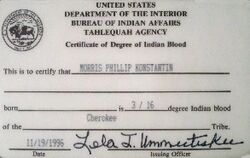Certificate of Degree of Indian Blood
Topic: Social
 From HandWiki - Reading time: 2 min
From HandWiki - Reading time: 2 min
A Certificate of Degree of Indian Blood or Certificate of Degree of Alaska Native Blood (both abbreviated CDIB) is an official United States document that certifies an individual possesses a specific fraction of Native American ancestry of a federally recognized Indian tribe, band, nation, pueblo, village, or community.[1] They are issued by the Bureau of Indian Affairs after the applicant supplies a completed genealogy with supporting legal documents such as birth certificates, showing their descent, through one or both birth parents, from an enrolled Indian or an Indian listed in a base roll such as the Dawes Rolls. Blood degree cannot be obtained through adoptive parents.[1] The blood degree on previously issued CDIBs or on the base rolls in the filer's ancestry are used to determine the filer's blood degree (unless they challenge them as inaccurate). Information collected for the filing is held confidential by privacy laws, except if the CDIB is related to assigned duties.[1]
A CDIB can show only the blood degree of one tribe or the total blood degree from all tribes in the filer's ancestry. Some tribes require a specific minimum degree of tribal ancestry for membership, which might require the first type of certificate, while some federal benefits programs require a minimum total Indian blood degree so an individual might require the second type of certificate to qualify. For example, the Eastern Band of Cherokee Indians requires at least 1/16 degree of Eastern Cherokee blood for tribal membership, whereas the Bureau of Indian Affairs' Higher Education Grant for college expenses requires a 1/4 degree minimum.[2]
A Certificate of Degree of Indian Blood does not establish membership in a tribe. Tribal membership is determined by tribal laws and may or may not require a CDIB or may require a separate tribal determination of ancestry or blood degree.[3]
The CDIB is controversial, from a racial politics perspective,[4] and because non-federally recognized tribes are neither eligible for the card nor for the benefits which require one. Some groups, such as the Cherokee freedmen, were often not eligible for a CDIB because they are not Native American by blood or their degree of blood was not recorded in the base rolls (where Freedman was used instead of stating a degree).[5]
See also
- Blood quantum laws
- Lineage-bonded society
- Pedigree chart
- Judicial aspects of race in the United States
References
- ↑ 1.0 1.1 1.2 "Certificate of Degree of Indian or Alaska Native Blood Instructions." Bureau of Indian Affairs. 31 July 2011 (retrieved 6 Feb 2011)
- ↑ "Federally Funded Programs". Citrus College. http://www.citruscollege.edu/stdntsrv/finaid/Pages/FederallyFundedPrograms.aspx. Retrieved 6 Feb 2011.
- ↑ "Native American Tribal Enrollment." Native American Rights Fund: National Indian Law Library. (retrieved 6 Feb 2011)
- ↑ Sturm, Circe (2002). Blood Politics: Race, Culture, and Identity in the Cherokee Nation of Oklahoma. University of California Press. ISBN 978-0-520-23096-5. https://www.jstor.org/stable/10.1525/j.ctt1pp3fr.
- ↑ "Sample Freedman Documents." African-Native American Genealogy. (retrieved 6 Feb 2011)
 |
 KSF
KSF
